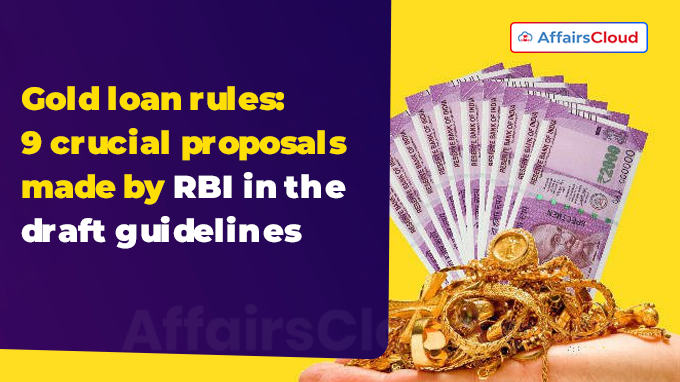 On May 2025, The Reserve Bank of India (RBI) has issued draft guidelines outlining the procedures for banks and non-banking financial companies (NBFCs) to issue gold loans to individuals.
On May 2025, The Reserve Bank of India (RBI) has issued draft guidelines outlining the procedures for banks and non-banking financial companies (NBFCs) to issue gold loans to individuals.
- The draft guidelines seek to establish uniform rules and regulations for getting gold loans from banks and NBFCs.
- The key changes proposed by the RBI include restrictions on eligible collateral, caps on loan amounts, and mandatory procedures for valuation and documentation.
Key Proposals:
i.Loan-to-Value (LTV) Ratio Capped at 75%:
- This means that if the pledged gold was worth Rs.100, the maximum loan amount would be around Rs.75.
- This marks a shift from the earlier relaxation during the Covid-19 pandemic, when the LTV was temporarily raised to 80% for certain segments
ii.Proof of Gold Ownership Required:
- The RBI draft proposes that borrowers must furnish proof of ownership for the gold that will be used as collateral.
- In case the original receipts of purchase of gold collateral are not available, a suitable document or declaration obtained from the borrower shall be prepared explaining how the ownership of the collateral has been determined.
iii.Borrowers to get a Gold Purity Certificate:
- Lenders must give a certificate of the gold’s purity and value when borrower takes a loan against gold.
- This certificate will contain details like carat purity, weight of the gold, any deductions (like stones or other materials), and the assessed value of your collateral
iv.Only Specific Gold Items Eligible as Collateral:
- According to the draft, only gold jewellery, ornaments, and specified gold coins are eligible as collateral for gold loan.
- The specified gold coins refer to specially minted gold with a purity of 22 carats or higher, sold by banks.
v.Loans Against Silver Now Allowed:
- Specially minted silver coins sold by banks with a minimum purity of 925 will now be acceptable as collateral under these draft guidelines.
vi.Loan Limit:
- As per the draft, the aggregate weight of gold ornaments pledged by a borrower should not exceed 1 Kilogram (kg), and the total weight of gold coins should not exceed 50 grams (gm) per borrower.
vii.Calculation of gold value for loan amount:
- The gold will be valued at the price of 22-carat purity, regardless of the actual purity of your gold.
- If the gold collateral is less than 22-carat purity, then the lender shall translate the collateral into equivalent 22-carat purity. Similarly, silver accepted as collateral shall be valued at 999 purity silver prices.
viii.Detailed Loan Agreements Mandatory:
- The loan document must include complete details of the pledged gold (description, weight, value, etc.), the process that will be followed if you default (for example, auction procedures and how/when you’ll be notified before any auction), the timeframe for returning your gold once the loan is repaid, and all fees or charges you might need to pay.
ix.Timely Release of Gold Collateral:
As per the proposal, the gold must be returned within 7 working days to the borrower after the full payment. In case of delay, the lender will pay Rs 5,000 for each day of delay.
AffairsCloud Recommends Oliveboard Mock Test
AffairsCloud Ebook - Support Us to Grow
Govt Jobs by Category
Bank Jobs Notification




